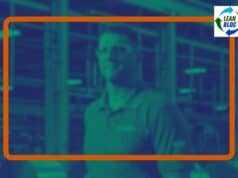Mark's note: Today's guest post is by Paul Critchley and he brings up important points about not reducing inventory too low before improving the capabilities of your system.

When I was first introduced to Lean in the late '90's, a popular saying used to describe the methodology was to “lower the water level and expose the rocks.”
The “water” represented all the waste that was present in the organization that hid the problems, otherwise known as the “rocks.”
Things like in-process rework, poor workplace organization and lengthy setups were problems that no one noticed because lots of inventory and available manpower made them invisible, like rocks lurking just below a water's surface.
It was a neat analogy, but it was also widely misunderstood and in many cases, just plain wrong.
Many companies (including some I was involved with), excited about the prospects of “becoming Lean,” jumped at the chance to incorporate the approach. Seeking to expose their problems quickly so they could get busy fixing them, managers would radically reduce finished goods inventory, institute a Just-In-Time delivery system between cells or start moving machines around under the umbrella of beginning their Lean journey.
For a short while afterward, things would look great. There was more available floor space, shorter part travel distances, and lower costs. These gains were really a mirage, though, since the proper steps hadn't been taken ahead of time to ensure that the new methods could be sustained. Really, all that had been taking place was the “burning off” of the buffer that had been built into place.
The goal of exposing the issues had been achieved but by the time those issues were exposed, it is was already too late to adequately handle the impact of having done so. The results were often serious if not catastrophic for a business. It only takes a few missed shipments, increased overtime/freight costs or a couple angry customer calls for a Plant Manager to fall off the Lean bandwagon for good.
Since then, I have learned to advocate the use of a fish finder before doing anything. For you non-fisherman, a fish finder is a general term for a boat-mounted sonar that you use to, frankly, find fish. It can also be used to map the bottom of your favorite fishing spots, so you know where potential prop-fouling logs, weeds, or rocks are lurking. The technology has proven invaluable more than once, and no doubt has saved many a person a frustrating day on the water.
The same is true for mapping a process. Don't lower the water level until you're ready to do so, which means knowing where the rocks are and preemptively removing them. A Value Stream Map is a great “sonar” to use as a first step in affecting change. The map will help everyone understand the process and where the issues are laying in wait. This is the step that many companies tend to skip, and it almost always costs them dearly. It's a whole lot easier, less stressful and more economical to fix an issue on your own schedule than it is when your customers are calling wondering where their parts are!
One note about this approach that's worth mentioning. Some folks balk a little at it since it tends to remove the “sense of urgency” associated with incorporating a change. They like the fact that once the water level is lowered and the rocks are exposed that there is an impending force associated with fixing issue(s). I believe this to be against the true nature of a Lean culture. The purpose isn't to push people into making a change; it's to empower them to do so.
The best decisions are not usually made when people are “under the gun.” A better method is to show your employees your belief in their abilities and expertise, and allow them the time they need to do it right. This may take a bit longer, but the long-term benefits are more than worth it.
About Paul Critchley:
Paul W. Critchley can be reached at www.newenglandleanconsulting.com. He lives in Connecticut with his wife and 2 beautiful daughters. Paul and his firm can also be found on Twitter, LinkedIn, and Facebook. See his bio below…
Please scroll down (or click) to post a comment. Connect with me on LinkedIn.
Let’s work together to build a culture of continuous improvement and psychological safety. If you're a leader looking to create lasting change—not just projects—I help organizations:
- Engage people at all levels in sustainable improvement
- Shift from fear of mistakes to learning from them
- Apply Lean thinking in practical, people-centered ways
Interested in coaching or a keynote talk? Let’s start a conversation.








![When Was the Last Time a Leader Around You Admitted They Were Wrong? [Poll]](https://www.leanblog.org/wp-content/uploads/2025/07/Lean-Blog-Post-Cover-Image-2025-07-01T212509.843-100x75.jpg)
